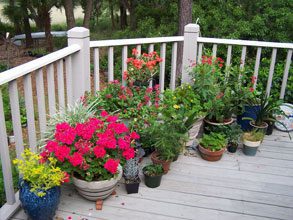 Chilly nights, shorter days and lots of moisture can be a great combination for establishing or moving woody shrubs and trees. Planning is always a good idea when the weather is too cold to work outside, and a drawing or picture of the property is helpful.
Chilly nights, shorter days and lots of moisture can be a great combination for establishing or moving woody shrubs and trees. Planning is always a good idea when the weather is too cold to work outside, and a drawing or picture of the property is helpful.
Include and locate utilities, sun direction, existing walks, buildings, decks, etc. Consider your views. These will include the property viewed by neighbors or passers-by from the front or street, or by you from inside through windows or going out doors. Brainstorming with a good garden guidebook can help with selections or planting techniques. You can order catalogues from garden supply, specialty landscape, and seed companies. Winter is usually when catalogues begin coming in the mail if you have ever ordered anything. It may be the time to plant spring bulbs and early vegetables.
While working outside in late fall or winter I like to layer on old clothes for insulation. Plants can use insulation too; having a pile of leaves, mulch or hay will come in handy for frost protection. There are commercially available light woven or spun fabrics at garden centers, but these will need some rocks, boards or bricks to keep them in place in the event of wind. Last year I carefully covered my blooming camellia one freezing night only to find the sheets had blown off the next morning, and all the blossoms were ruined. Some gardeners build temporary shelters or lean-to mini-greenhouses out of plastic sheeting, flexible pipe, wood, or hay bales. Remember to keep plastic sheeting from touching the leaves, because it can act like a magnifying glass under the sun and burn or scorch leaves. Always allow for ventilation when the sun is out to prevent excessive heat build-up. Old bed sheets, beach towels and quilts can give frost protection in a pinch.
Cleaning up beds and lawns is necessary for sanitation. Any diseased annual, perennial plant, or weed can be removed and destroyed or bagged up. This will help prevent the spread of pathogens and pests. It is especially important to pick up or rake all the fallen camellia blooms to minimize blossom blight. If shrubs are showing signs of insect damage prune out the worst branches and spray with dormant oil after they have finished blooming. Hard pruning of evergreens is not recommended until the end of February or March. Raking leaves may seem necessary, but those leaves contain the minerals and nutrients that the roots mined from the soil. Recycling the nutrients is obviously important to the deciduous trees. Instead of bagging or taking them to the curb, consider mowing with a mulching mower or storing them out of sight. This will reduce landfill waste and the leaf mold can be used as a mulch or soil enriching compost.
Planting woody shrubs and trees in the fall and winter is especially good for root development. The roots have an opportunity to grow without the pressure of evaporative transpiration that occurs during warmer temperatures. Remember to properly site plants where they can achieve mature spread, form and height without overgrowing the available space. As woody plants mature they may shade out other plantings and need to be kept away from buildings, sidewalks, and roofs. There are so many selections of plant material available that there is probably one that is the right fit for your landscape. Too many times gardeners purchase plants without knowing where to plant them or if they should be planted at all. The word plant starts with “plan.”
There are some great blooming flowers that can take the cold and give color and interest in the grey days of winter. Sweet smelling and old timey plants like stocks, sweet alyssum, violas, calendula, snapdragons, nemesia, blue lobelia, and evergreen herbs are great in beds or containers and most will keep blooming with a little dead head pinching. Cut flowers and bring them inside for arrangements or vases. Herbs that may flag in heat but keep on going in cool seasons are parsley, cilantro, and chives. Giving texture, fragrance, flavor, filling out the palette and palate, herbs are extra nice garden additions. Relax from your chores, curl up with a stack of garden catalogues and some mint tea to take off the winter chill.






